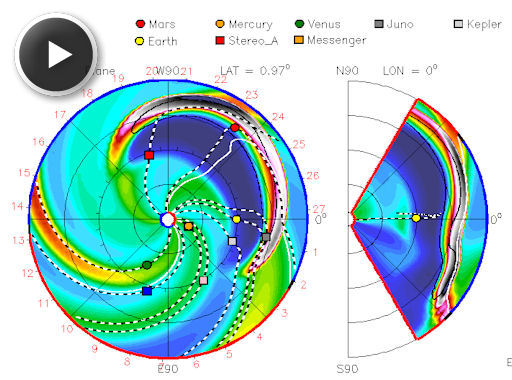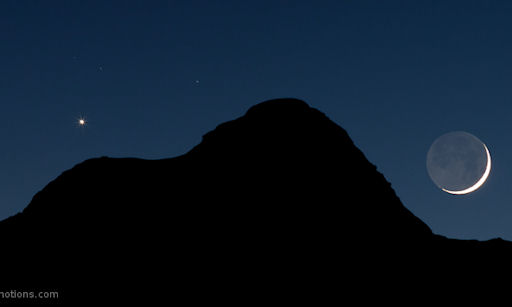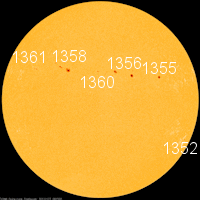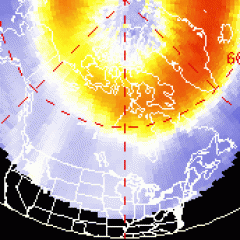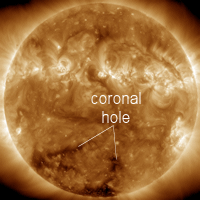~SPACE WEATHER UPDATE~ 11~27~11

RADIATION STORM AND CME ALERT:
A solar radiation storm is in progress around Earth. At the moment, the storm is classified as minor, which means it has little effect on our planet other than to disturb HF radio transmissions at high latitudes. Bigger effects, however, may be in the offing. The same explosion on Nov. 26th that caused the radiation storm also hurled a CME into space at about 930 km/s (2 million mph). According to analysts at the Goddard Space Weather Lab, the CME will reach Earth on Nov. 28th at 17:21 UT (+/- 7 hours). Click to view an animated forecast track:
The impact of the cloud could trigger a geomagnetic storm. Indeed, NOAA forecasters estimate a 58% chance of severe storming around the poles when the CME arrives. High-latitude sky watchers should be alert for auroras after nightfall on Monday. Aurora alerts: text, phone.
SUNSET CONJUNCTION: Last night, the slender crescent Moon passed by Venus in the fading glow of sunset. "Crystal clear skies offered the perfect view of the pair setting over this hillside in western Colorado," says Thad V'Soske, who captured the scene using a Canon 30D digital camera:
The Moon is moving away from Venus now--but it will be back. On Dec. 26th, the crescent Moon and Venus will reprise their close encounter for a lovely night-after-Christmas sky show. Browse the links below for a preview.
more images: from Mohammad Mehdi Asgari of Bayandor, Zanjan, Iran; from Fred Espenak of Portal, Arizona; from Amirreza Kamkar of Qayen, Iran; from Mitsuo Muraoka of Hatoyama, Saitama, Japan; from Francesc Pruneda of Batet de la Serra, Spain; from Erika Rix of Zanesville,OH; from Kosma Coronaios of Louis Trichardt, South Africa; from Joseph Kline of Tucson, Arizona; from David Blanchard of Flagstaff, Arizona; from Robert T. Smith of Stoneville, NC; from Jimmy Westlake of Twin Lakes, Colorado; from Mark Seibold of Portland Oregon; from Adrian New of Castroville, Texas; from Paul Johnston of West Point, New York; from Doug Schmutz of Hamblin Valley, Utah; from Jan Curtis of Santa Fe, NM; from Pete Strasser of Tucson, Arizona;

Solar wind
speed: 402.6 km/sec
density: 2.5 protons/cm3
explanation | more data
Updated: Today at 1646 UT
X-ray Solar Flares
6-hr max: C1 1102 UT Nov27
24-hr: C1 1102 UT Nov27
explanation | more data
Updated: Today at: 1600 UT
![]()
Daily Sun: 27 Nov 11
Sunspot 1358 poses a slight threat for Earth-directed M-flares. Credit: SDO/HMI
![]()
Sunspot number: 133
What is the sunspot number?
Updated 26 Nov 2011
Spotless Days
Current Stretch: 0 days
2011 total: 2 days (<1%)
2010 total: 51 days (14%)
2009 total: 260 days (71%)
Since 2004: 821 days
Typical Solar Min: 486 days
Updated 26 Nov 2011
The Radio Sun
10.7 cm flux: 133 sfu
explanation | more data
Updated 26 Nov 2011
![]()
Current Auroral Oval:
Switch to: Europe, USA, New Zealand, Antarctica
Credit: NOAA/POES
![]()
Planetary K-index
Now: Kp= 1 quiet
24-hr max: Kp= 3 quiet
explanation | more data
Interplanetary Mag. Field
Btotal: 3.9 nT
Bz: 2.5 nT north
explanation | more data
Updated: Today at 1648 UT
![]()
Coronal Holes: 27 Nov 11
Solar wind flowing from this southern coronal hole could reach Earth on Nov. 29. Credit: SDO/AIA.

